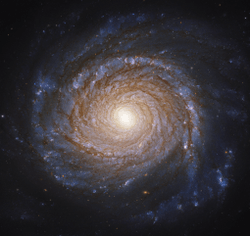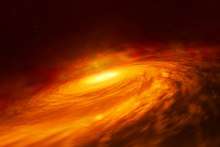NGC 3147
NGC 3147 is a spiral galaxy located in the constellation Draco. It is located at a distance of circa 130 million light years from Earth, which, given its apparent dimensions, means that NGC 3147 is about 140,000 light years across. It was discovered by William Herschel on April 3, 1785.[2] It is a Type II Seyfert galaxy.
| NGC 3147 | |
|---|---|
 NGC 3147 by Hubble Space Telescope | |
| Observation data (J2000 epoch) | |
| Constellation | Draco |
| Right ascension | 10h 16m 53.7s[1] |
| Declination | +73° 24′ 03″[1] |
| Redshift | 0.009346 ± 0.000003 [1] |
| Helio radial velocity | 2,802 ± 1 km/s[1] |
| Distance | 129 ± 29 Mly (39.6 ± 8.9 Mpc)[1] |
| Apparent magnitude (V) | 10.6 |
| Characteristics | |
| Type | SA(rs)bc [1] |
| Apparent size (V) | 3′.9 × 3′.5[1] |
| Notable features | Seyfert galaxy |
| Other designations | |
| UGC 5532, MCG +12-10-025, PGC 30019[1] | |
Structure
The galaxy has a small and bright nucleus and tightly wound multiple spiral arms. The overall appearance of the galaxy resembles that of NGC 488, however the nuclear bulge is smaller. The arms consist of spiral segments that branch after approximately one quarter of a revolution. HII regions can be detected in the arms.[3]
Active galactic nucleus
NGC 3147 has been characterised as a Seyfert II galaxy. It is considered the best candidate to be a true type II Seyfert galaxy,[4] galaxies which feature optical/UV spectrum lacking broad emission lines due to the lack of the broad line region rather than its obscuration, since the nucleus is simultaneously seen unobscured in the X-rays.[5]
The galaxy was observed stimultaneously in the optical and X-ray spectrum by Bianchi et al. and concluded that the X-ray spectrum is unabsorbed while its optical spectrum lacks broad lines, a mismatch with respect to the Unification Model.[6] Birghtman et al. confirmed their findings and also noted that the hard X-ray flux dropped by a factor of ∼2 between the observation by Chandra (2001) and XMM-Newton (2006).[7] Further flux variation was observed by Suzaku in 2010, confirming the variability of the source.[4] The nuclear emission in the UV band shows negligible variability.[8] Shi et al. used data from Spitzer Space Telescope and ground-based optical spectropolarimeteric observations and observed lack of polarised broad emission lines in NGC 3147.[9] NGC 3147 was observed by NuSTAR at the 3-40 keV X-ray spectrum, which is characterised by a simple power-law, with a standard Γ ∼ 1.7 and an iron emission line, with no need for any further component up to ∼ 40 keV.[5]
There is a debate whether the lack of broad lines detection observed with NGC 3147 is caused by the presence of an Compton-thick column with the presence of a highly ionised reflactor to account for the X-ray spectrum or not.[5] Bianchi et al. rejected the presence of a Compton thick column on the grounds of low-equivalent width of the iron Kα line (≃130 eV), and of the large ratio between hard X-ray and [O III] fluxes.[6] Birghtman et al. confirmed their findings using data from XMM-Newton and Chandra. They also found that the X-ray flux is variable, meaning that the nucleus may be observed directly. However, they noted the presence of Compton-thick column cannot be ruled out.[7] The observations by Suzaku in the hard X-rays spectrum didn't cast more light,[4] but along with the observations performed by XMM-Newton put tight constraints on the column density.[5]
After the observations by NuStar in 2015, Bianchi et al. concluded that the spectral properties and the significant variability on time-scales as short as weeks strongly support an unobscured line-of-sight for the nucleus of NGC 3147 and the Compton-thick scenario is strongly disfavoured.[5]
Central black hole with thin disk

In July 2019 researchers using the Hubble Space Telescope Imaging Spectrograph reported the presence of a thin disk of material around a supermassive black hole at the center of NGC 3147. The black hole is 250 million times as massive as the Sun. Black holes at the center of galaxies of such low activity have been considered to be "malnourished" or "starving", that is, little or no material would be falling into the black hole to feed it. The presence of a disk that is similar to the much brighter disks surrounding the black hole of more active galaxies was surprising, since models of low activity galaxies did not predict it. The disk is also unusual because it is deep within the gravitational well of the black hole and rotates around it at more than 10% of the speed of light. Its high velocity results in the effect known as relativistic beaming, in which the light coming from the side moving toward the Earth is brighter than that coming from the side that is receding.[11][12]
Supernovae
Four supernovae have been discovered in NGC 3147: SN 1972H (mag. 15.1[13]), SN 1997bq (mag. 14.5, type Ia[14]), SN 2006gi (mag. 15.6, type Ib[15]), and SN 2008fv (mag. 14.8, type Ia[16]).
Nearby galaxies
NGC 3147 is the brightest galaxy in the NGC 3147 group, which also includes NGC 3155, UGC 5570, UGC 5686, and UGC 5689. A bit further away lie NGC 3183, NGC 3348, NGC 3364, and NGC 3516.[17]
See also
- NGC 6814 - a similar galaxy
References
- "NASA/IPAC Extragalactic Database". Results for NGC 3147. Retrieved 2016-01-18.
- NGC 3147 cseligman.com
- Sandage, A.; Bedke, J. (1994). The Carnegie Atlas of Galaxies, Volume 1. Carnegie Institution of Washington. p. 20.
- Matt, G.; Bianchi, S.; Guainazzi, M.; Barcons, X.; Panessa, F. (6 April 2012). "The Suzaku X-ray spectrum of NGC 3147". Astronomy & Astrophysics. 540: A111. arXiv:1204.0946. Bibcode:2012A&A...540A.111M. doi:10.1051/0004-6361/201118729.
- Bianchi, Stefano; Marinucci, Andrea; Matt, Giorgio; Middei, Riccardo; Barcons, Xavier; Bassani, Loredana; Carrera, Francisco J.; La Franca, Fabio; Panessa, Francesca (July 2017). "The NuSTAR view of the true type 2 Seyfert NGC 3147". Monthly Notices of the Royal Astronomical Society. 468 (3): 2740–2744. arXiv:1703.04586. Bibcode:2017MNRAS.468.2740B. doi:10.1093/mnras/stx662.
- Bianchi, S.; Corral, A.; Panessa, F.; Barcons, X.; Matt, G.; Bassani, L.; Carrera, F. J.; Jiménez-Bailón, E. (31 January 2008). "NGC 3147: a 'true' type 2 Seyfert galaxy without the broad-line region". Monthly Notices of the Royal Astronomical Society. 385 (1): 195–199. arXiv:0710.4226. Bibcode:2008MNRAS.385..195B. doi:10.1111/j.1365-2966.2007.12625.x.
- Brightman, Murray; Nandra, Kirpal (1 November 2008). "On the nature of unabsorbed Seyfert 2 galaxies". Monthly Notices of the Royal Astronomical Society. 390 (3): 1241–1249. arXiv:0808.2385. Bibcode:2008MNRAS.390.1241B. doi:10.1111/j.1365-2966.2008.13841.x.
- Andreoni, I.; D’Avanzo, P.; Campana, S.; Branchesi, M.; Bernardini, M. G.; Della Valle, M.; Mannucci, F.; Melandri, A.; Tagliaferri, G. (4 March 2016). "A time domain experiment with Swift: monitoring of seven nearby galaxies". Astronomy & Astrophysics. 587: A147. arXiv:1601.03739. Bibcode:2016A&A...587A.147A. doi:10.1051/0004-6361/201527167.
- Shi, Yong; Rieke, George H.; Smith, Paul; Rigby, Jane; Hines, Dean; Donley, Jennifer; Schmidt, Gary; Diamond-Stanic, Aleksandar M. (1 May 2010). "UNOBSCURED TYPE 2 ACTIVE GALACTIC NUCLEI". The Astrophysical Journal. 714 (1): 115–129. arXiv:1004.2077. Bibcode:2010ApJ...714..115S. doi:10.1088/0004-637X/714/1/115.
- "Hubble Discovers Mysterious Black Hole Disc". www.spacetelescope.org. Retrieved 13 July 2019.
- "Hubble discovers mysterious black hole disc", ESA/Hubble Information Center news release, 11 July 2019.
- "Hubble uncovers black hole that shouldn't exist", NASA/Goddard Space Flight Center news release, 11 July 2019.
- "1972H - The Open Supernova Catalog". sne.space.
- "1997bq - The Open Supernova Catalog". sne.space.
- "2006gi - The Open Supernova Catalog". sne.space.
- "2008fv - The Open Supernova Catalog". sne.space.
- Makarov, Dmitry; Karachentsev, Igor (21 April 2011). "Galaxy groups and clouds in the local (z∼ 0.01) Universe". Monthly Notices of the Royal Astronomical Society. 412 (4): 2498–2520. arXiv:1011.6277. Bibcode:2011MNRAS.412.2498M. doi:10.1111/j.1365-2966.2010.18071.x.
External links
| Wikimedia Commons has media related to NGC 3147. |
- NGC 3147 on WikiSky: DSS2, SDSS, GALEX, IRAS, Hydrogen α, X-Ray, Astrophoto, Sky Map, Articles and images